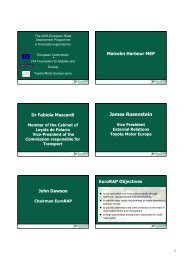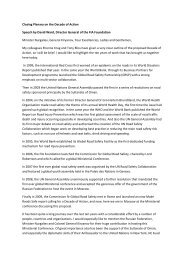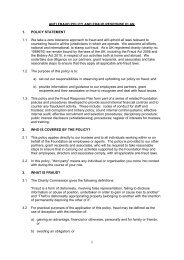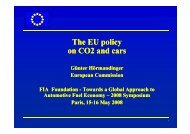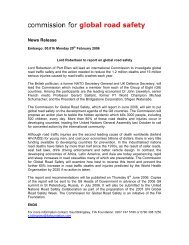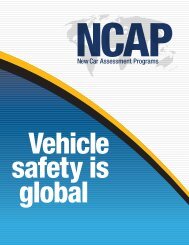Download Executive Summary (PDF - 1mb) - FIA Foundation
Download Executive Summary (PDF - 1mb) - FIA Foundation
Download Executive Summary (PDF - 1mb) - FIA Foundation
You also want an ePaper? Increase the reach of your titles
YUMPU automatically turns print PDFs into web optimized ePapers that Google loves.
<strong>FIA</strong> <strong>Foundation</strong><br />
for the Automobile and Society<br />
The Automobile and Society<br />
<strong>Executive</strong> summary
The automobile in industrialised society<br />
An introduction to the transport data<br />
Cars per person<br />
800<br />
700<br />
600<br />
500<br />
400<br />
300<br />
200<br />
100 0<br />
Difference represents<br />
SUVs, minivans and<br />
pickups<br />
1970 1976 1980 1985 1990 1995 2000 2005<br />
= The automobile dominates passenger travel. At least 75% of<br />
distance travelled is by car, except in Japan (63%) and Spain (69%).<br />
= Car ownership is rising in every country.<br />
= Transport is a major part of household expenditure - on average<br />
about 14% of all expenditure. About 85% of this expenditure is for<br />
the purchase and use of cars.<br />
= For journeys up to 40 km long, travel by car takes no more than half<br />
the time door to door as travel by bus or rail, except along a few<br />
corridors suitable for heavy rail or express bus.<br />
= A car allows access to wider choice and better opportunities for<br />
employment, homes, and key services.<br />
= Congestion is a growing problem in some areas. But overall,<br />
average door to door travel times are not increasing.<br />
= Road safety is improving. Fatalities per vehicle kilometre have<br />
fallen by a factor of three since 1980, and by a factor of five in some<br />
countries since 1970.<br />
= Emission of toxic pollutants from cars has fallen dramatically. A new<br />
car today is around 30 times cleaner than a new car in the early 1980’s .<br />
= Cars are now responsible for less than 15% of greenhouse<br />
emissions worldwide, and some 15-20% of greenhouse emissions<br />
from developed countries. Governments and car manufacturers are<br />
taking serious steps to improve fuel efficiency through technology.<br />
= Car drivers pay up to four times more in road user taxes than the<br />
amount reinvested in transport.<br />
UK<br />
Canada<br />
France<br />
Germany<br />
Italy<br />
Japan<br />
Spain<br />
USA (all 4tyre)<br />
USA (autos)<br />
1
Mobility: the role of the car<br />
= Rising car ownership causes similarities in overall travel patterns in<br />
developed countries, particularly the dominant role of the car. Many<br />
current trends in Europe are similar to those experienced in USA<br />
twenty years ago.<br />
= Within this overall similarity, almost every detail of travel patterns in<br />
Europe and USA is different.<br />
= For individuals, in USA cars are used more and fewer trips are made<br />
by walking and public transport than in Europe: the differences<br />
between USA and Japan are even greater.<br />
Characteristics of personal travel, Europe and USA<br />
Europe<br />
Means of transport<br />
Car<br />
Walk<br />
Pedal cycle<br />
Train<br />
Air<br />
Other public transport<br />
Personal travel<br />
Average trip<br />
numbers<br />
Average trip length<br />
Average travel time<br />
Trips<br />
%<br />
62<br />
25<br />
*<br />
1<br />
eginning to be more like shoes, where different sets are kept for<br />
different occasions.<br />
= Using a car enables people to travel further in the same time. As car<br />
ownership has increased, the average distance travelled per year<br />
has also risen.<br />
= The journeys people make by car are different to those by public<br />
transport. Car trips are from anywhere to anywhere, and are often<br />
across town or round the edge of towns. Public transport trips are<br />
along corridors where many people travel, often radial into the<br />
centres of towns.<br />
= The majority of long journeys are for personal rather than<br />
professional reasons. In Britain, the proportion increases from<br />
58% for journeys of 120 - 160 km to 67% for journeys over<br />
560 km. In France, about 80% of long journeys are for personal<br />
reasons.<br />
= In Britain and France, over 70% of long distance travel up to 500 km<br />
is by car.<br />
Travel by car<br />
= Except for Japan, over 83% of distance travelled is by road, of<br />
which over 80% is by car. In most countries 75 - 85% of the<br />
total distance travelled is by car, except in Japan (63%) and Spain<br />
(69%).<br />
= The average distance travelled per person per year by car ranges<br />
from 6,190 km in Japan to 23,130 km in USA.<br />
= The average annual distance travelled per car varies from 9,300 km<br />
per car per year in Japan to 19,100 km in USA.<br />
The car and social issues<br />
= In general, household car ownership increases as household<br />
income increases.<br />
= People travel more, the easier their access to a car. The less access<br />
they have to a car, the more they walk and use public transport.<br />
= For journeys up to 40 km long, travel by car takes no more than half<br />
the time door to door as travel by bus or rail, except along a few<br />
corridors suitable for heavy rail or express bus.<br />
3
= On average, the fuel-only cost of car travel is about one-third<br />
the cost of bus or rail fares, even after subsidies for public<br />
transport.<br />
= Cars enable their users to travel further to obtain access<br />
to better jobs, houses, goods and services. Travel by car<br />
saves time and increases opportunities for a wide range of<br />
activities. Because car ownership is lower among poorer<br />
people, the transport system can reinforce poverty and increase<br />
social exclusion. This is now a significant concern in some<br />
countries.<br />
= Because most public transport journeys are along heavily<br />
travelled corridors while car journeys are from scattered<br />
origins to scattered destinations, improved public transport is<br />
only an attractive alternative for a small proportion of car<br />
journeys.<br />
Traffic levels and congestion<br />
= Traffic flows are increasing, but the rate of increase differs greatly<br />
between areas. Traffic is hardly increasing in central cities and<br />
growing most rapidly on inter-urban motorways.<br />
= Traffic flows on motorways are higher in Britain than any other G7<br />
country. They are 50% higher than in Germany, the next busiest,<br />
and almost twice as high as in USA or Japan.<br />
= Average traffic flows on all roads are higher in Britain than any other<br />
G7 country. They are 25% higher than in Germany, the next busiest,<br />
and almost twice as high as in USA or Japan.<br />
= Average door to door travel time is not increasing. The car is<br />
providing more journeys, enabling people to cover more distance,<br />
without increasing the time spent travelling.<br />
= Nevertheless, congestion is increasing in some localised situations.<br />
Congestion measured as the excess time taken by motorists<br />
because of traffic delays is increasing, particularly in urban areas in<br />
USA and on inter-urban roads in Britain.<br />
= Road pricing is in use in London as a demand management<br />
measure and to raise funds for transport improvements, and in a<br />
number of other European cities principally to raise funds for<br />
transport investment. Pricing on inter-urban roads is currently used<br />
to fund road maintenance and investment, but not to manage<br />
demand.<br />
4
Safety<br />
= In all the G7 countries, road accident fatalities and the fatality rates<br />
per population and per vehicle kilometre have been falling. In most<br />
of them, the fatality rate per vehicle km reduced by a factor of about<br />
3 between 1980 and 1999, and probably by a factor of about five<br />
since 1970, when the number of fatalities was at its highest in<br />
several countries.<br />
Road accident deaths per billion vehicle km<br />
100<br />
80<br />
60<br />
40<br />
20<br />
0<br />
1980<br />
1990<br />
1999<br />
= The EU15 states have a target to halve road traffic fatalities by 2010.<br />
Individual states have national targets and visions for road safety. It<br />
is clear that safety will continue to improve.<br />
= Despite the improvements in road safety since 1970, in 1999 there<br />
were 42,122 persons killed in traffic accidents in EU15, 41,611 in<br />
USA and 10,805 in Japan.<br />
= These figures for road accident fatalities in Europe compare with 186<br />
railway passengers and 25 airline passengers.<br />
= Of the countries surveyed USA has the highest road accident<br />
fatality rate per population, at 153 per year per million, and Britain<br />
the lowest, at 59 per year per million.<br />
= Spain has the highest fatality rate per unit traffic, at 28 per billion<br />
vehicle km, and Britain the lowest, at 7 per billion vehicle km.<br />
5
= In all the G7 countries except Japan, car occupants are half or more<br />
of all fatalities.<br />
= In both Britain and Japan, a high proportion of fatalities, over 25%,<br />
are pedestrians.<br />
= Britain, Italy and Japan have a high proportion of fatalities in urban<br />
areas, over 40% of the total. Spain has the lowest proportion, at<br />
18%.<br />
= Motorways are very safe roads. In most G7 countries the fatality<br />
rate per vehicle kilometre is about one-third that on other roads.<br />
Despite carrying typically 18% to 28% of all traffic, only 3% to 8% of<br />
all injury accidents and 6% to 16% of all fatalities occur on motor<br />
ways.<br />
= Road safety measures can be categorised as: decreasing exposure<br />
(vehicle miles travelled); decreasing collision risk; and decreasing<br />
the risk of death or injury. Risk of death or injury has been reduced<br />
by improved vehicle design, improved roadside furniture and<br />
protective equipment such as seat belts and air bags. Seat belt use<br />
by drivers and front seat passengers varies from 96% in Germany to<br />
around 30% in the Czech Republic.<br />
Environment<br />
Air quality<br />
= Emissions of toxic pollutants from road transport have been falling<br />
s t e a d i l y, despite rising traffic. This has been the result of<br />
improvements to engine technology, including the use of exhaust<br />
catalysts, and of tougher fuel quality standards.<br />
= In the USA, allowable emissions of CO from cars has reduced to 4%<br />
of the amount emitted before legislative controls; alowable emission<br />
of hydrocarbons is 4%, and from 2004 will be 1%; and of NOx is 10%<br />
and from 2007 will be 4%. Further planned reductions in emission<br />
limits for vehicles in USA and EU15 will further reduce emissions per<br />
vehicle km by factors of at least two for most pollutants.<br />
= These improvements have been made possible by improvements in<br />
the specifications for petrol and diesel fuel. As well as the reduction,<br />
and eventual elimination, of lead in petrol, the amount of sulphur in<br />
both petrol and diesel has been reduced by a factor of 10 since<br />
1990, and will be further substantially reduced throughout Europe by<br />
2005.<br />
6
= Air quality in urban areas is improving. This is partly a result of<br />
transport becoming cleaner and partly due to emissions from<br />
non-transport sources of pollution being reduced.<br />
= In particular, concentrations of lead have been falling since 1980,<br />
and those of carbon monoxide, and various volatile organic<br />
compounds and oxides of nitrogen since at least the mid-1990s.<br />
= In US metropolitan areas, the number of days on which at least one<br />
air quality limit was exceeded has been falling since at least the late<br />
1980s.<br />
= Improving technology is dramatically reducing the impact of cars on<br />
air quality, though it is too soon to claim that the problem has been<br />
completely overcome. Traffic has not been restricted to improve air<br />
quality, except in a few, short-term, extreme incidents.<br />
Greenhouse gas emissions<br />
= Worldwide emissions of carbon dioxide, the principal manmade<br />
greenhouse gas, rose 9 percent between 1990 and 1998.<br />
Transport CO2 emissions<br />
800<br />
150<br />
10<br />
50<br />
0<br />
1982 1986 1988 1990 1992 1994 1996 1998 2000<br />
UK<br />
France<br />
Germany<br />
Italy<br />
Spain<br />
USA x 1/10<br />
7
= Transport produces a small part of the worldwide emission of greenhouse<br />
gases (probably between 10% and 16% of the total). In USA,<br />
transport uses 28% of the national energy consumption and emits<br />
33% of the carbon dioxide. In EU15, transport emits 29% of the<br />
carbon dioxide. In less developed countries, transport emits a smaller<br />
percentage of the total carbon dioxide emissions. Cars emit about<br />
15% of the total carbon dioxide in EU15, and about 19% in USA.<br />
= In USA, the total emission of CO2 rose 11% during the 1990s, with<br />
transport rising by 19% and road transport by 16%.<br />
= In EU15, emission of carbon dioxide CO2 has been almost constant<br />
since the mid-1980s, but within this total, emission from transport<br />
has been rising.<br />
= In Britain, emission of CO2 by road transport has been almost<br />
constant since 1990. Within this total, emissions from road freight<br />
are rising, but emissions from cars have fallen marginally since<br />
1993, despite a 12% increase in traffic.<br />
= The US CAFE (Corporate Average Fuel Efficiency) standards have<br />
not been made more demanding since 1985 for cars and since 1995<br />
for light trucks. Light trucks (e.g. SUVs, pick-ups etc) are allowed to<br />
use 33% more fuel than cars.<br />
= In 1998, the representatives of motor manufacturers from Europe,<br />
Japan and Korea committed to reduce the new car fleet average fuel<br />
consumption by 25% in 2008 (relative to 1995) in agreement with the<br />
European Commission. Improvements already introduced have<br />
reduced the new car fleet average fuel consumption in Europe in<br />
2001 by 11.4% relative to 1995. This should compensate for<br />
European traffic growth as these vehicles replace less efficient ones.<br />
Noise<br />
= Allowable noise levels for vehicles have been steadily reduced, so<br />
that by 1996, the engine and exhaust of a heavy lorry made less<br />
noise than those of a car in 1972, and 10 cars made about the same<br />
noise as one did in 1972.<br />
= Tyre noise is being reduced by improvements to tyres and road<br />
surfaces, and noise barriers are being used to protect noise<br />
sensitive areas.<br />
= Despite these developments, road traffic is the external source of<br />
noise that is heard indoors by the largest number of households, and<br />
is the noise heard indoors that causes nuisance to most people.<br />
8
Finance and the cost of motoring<br />
Taxation of road users and government spending on transport<br />
= Road transport offers such great advantages to its users that it is a<br />
favourite source of revenue for governments. However, there are<br />
indications in several countries that current levels of taxation of road<br />
users are close to the limit of acceptability.<br />
= Each country has its own systems of obtaining taxation revenues<br />
from road users and of providing funds for the construction<br />
and operation of transport facilities. There is a great difference<br />
between North America and Europe in the balance between<br />
revenue from road users and the spending on roads, and indeed in<br />
the attitude to transport investment as a necessary support for<br />
the economy.<br />
= In USA, government spending on highways roughly matches<br />
taxation revenue from highway users. Spending on other forms of<br />
transport well exceeds revenue from transport users. A similar<br />
situation applies in Canada.<br />
= In Europe it is common for governments to use motorists as a source<br />
of taxation for general revenue. In Spain, taxation from motorists<br />
is four times, and in Britain five times, the amount spent by<br />
government on roads. However, due to spending on other types<br />
of transport, Spanish taxation revenue is only about twice the total<br />
of government spending on all forms of transport, and in Britain<br />
about four times.<br />
= In France, revenue from road users approximately matches<br />
government spending on all forms of transport, but is about twice as<br />
much as government spends on roads.<br />
= In Germany, since 1990, revenue from road users has exceeded<br />
total government spending on all forms of transport (excluding a part<br />
of funding for public transport).<br />
National economy<br />
= Transport is a major part of the economic activity of developed<br />
countries, typically involving 12% to 19% of the national GDP.<br />
= National statistics suggest that 4% to 8% of jobs are in car and<br />
transport related activities, but when a wider definition of transport<br />
related jobs is used, the percentage is higher.<br />
9
= Countries that have indigenous car industries tend to be<br />
chauvinistic in their car purchases. The high proportion of<br />
indigenous cars purchased in France, Germany, Italy and Japan is<br />
striking. Despite its indigenous industry, USA is now purchasing<br />
40% of its new cars from Japanese and other Asian manufacturers.<br />
= Official figures classify employment in transport as 4 - 8% of all jobs,<br />
but when transport-related activities are included, the proportion is<br />
higher than this.<br />
Purchases of cars in different countries - 2001<br />
100<br />
90<br />
80<br />
70<br />
60<br />
50<br />
40<br />
30<br />
20<br />
10<br />
0<br />
country in which car purchased<br />
Household spending on transport<br />
France<br />
Germany<br />
Italy<br />
Sweden<br />
Britain<br />
USA<br />
Japan<br />
other Asian<br />
= Transport is a major part of household expenditure. In European<br />
countries the average household spends some 1,750 - 1,850<br />
Euro/year on car travel (85% of all spending on travel) and 200-300<br />
Euro/year on all other travel. Spending on travel is typically 11 -<br />
16% of total household expenditure. For households in Britain that<br />
own a car, motoring is the biggest single item of household spending.<br />
In the collection of these statistics, many inconsistencies, differences of definition and examples of<br />
missing data have been found. Readers should appreciate that data such as traffic flows may be<br />
uncertain to within 5%, number of vehicles to at least 2%, and financial information to possibly greater<br />
uncertainty. The overall patterns described here are believed to provide a fair picture of reality, but<br />
detailed individual results need to be treated with caution.<br />
Financial statistics for Eurozone countries are given in Euros. For Britain, USA and Canada, for which<br />
the rates of exchange vary, rates of exchange have been chosen that were typical of those in force<br />
in 2001-02. These are 1 US$ = 1 Euro, 1 Canadian $ = 0.647 Euro and 1 £ sterling = 1.57 .<br />
other<br />
10
The motorist in industrialised society<br />
An introduction to the opinion research<br />
A major survey of motorists across eight countries has been conducted for<br />
the Automobile and Society Report. Eight national surveys were conducted<br />
(each reported in detail in the national sections) by polling organisation<br />
MORI and her international partners. This report discusses the overall<br />
findings and draws comparisons across countries and between key cities.<br />
The objectives of the research were to understand the role of the car - and<br />
in particular the attitudes of motorists towards their cars - in today’s<br />
industrialised societies. In particular, the research aimed to assess the<br />
extent of self-perceptions of car dependency amongst motorists; the degree<br />
of their identification with their cars; and their willingness - or resistance - to<br />
change and to the instruments of car restraint and modal shift.<br />
Key findings<br />
= The large majority of drivers acknowledge the car as a central and<br />
critically important part of their own lives, and of their country’s prosp<br />
e r i t y, despite some misgivings over the car’s impact on quality of life.<br />
= Despite the progress made in road and vehicle safety, the risk of<br />
accidents emerges as a prime concern for motorists - and indeed<br />
ranks top in 4 out of the 8 countries surveyed.<br />
= In all countries, the price of fuel doubling has a potentially far greater<br />
impact on reducing car usage than does the cost of public transport<br />
halving.<br />
= Indeed, excessive cost seems to be the main catalyst in forcing<br />
drivers (though by no means all of them) to part with their cars.<br />
= When thinking about the future the most widespread expectation is<br />
that, as drivers, they will increasingly have to spend more of their<br />
income on motoring.<br />
= There is also expectation of tightening controls, both in terms of car<br />
usage generally and the environmental credentials of vehicles which<br />
are used.<br />
Attitudes to the car<br />
More than half of drivers (56%) as a whole say they would find day-to-day<br />
tasks more difficult if they no longer had a car:<br />
= this rises to nearer three-quarters among those living in the US or<br />
Germany;<br />
11
= Italy and Spain buck the trend with just 27% and 44% respectively<br />
feeling that no longer having a car would make daily life more<br />
difficult.<br />
Consequences of no longer having a car<br />
Q. If you no longer had a car which, if any, of the following<br />
consequences would you expect to apply to you?<br />
100<br />
80<br />
60<br />
40<br />
20<br />
0<br />
‘Day-to-day tasks would become more difficult’<br />
Base: All drivers (11,884) Source: MORI<br />
Half (51%) of drivers say they would spend more time using public transport<br />
if they no longer had a car. Again we see some marked variations across<br />
the countries with the Germans and Japanese being apparently most willing<br />
(or able) to use public transport, and French and Italians being least<br />
likely to.<br />
On a city or state basis, a transatlantic divide appears, with those living in<br />
California or Toronto having very different views about the effect being ‘car<br />
less’ would have on their everyday lives:<br />
= those in Toronto or California are twice as likely as those<br />
in European capitals to feel that not having a car would<br />
impinge upon their social lives and force them to find a new<br />
job.<br />
29% of Parisians said they would be unaffected by not having a car - in stark<br />
comparison to just 1% of those living in Toronto.<br />
12
Consequences of no longer having a car<br />
Q. If you no longer had a car which, if any, of the following<br />
consequences would you expect to apply to you?<br />
100<br />
80<br />
60<br />
40<br />
20<br />
0<br />
‘I would spend more time using public transport’<br />
Base: All drivers (11,884) Source:MORI<br />
Base: All drivers (11,884) Source: MORI<br />
In terms of attitudes to the car, when asked to respond to positive and<br />
negative statements about the car, there appears often to be a split between<br />
France / Spain / Italy and USA / Germany / Japan.<br />
For example, the majority of drivers as a whole (60%) disagree that<br />
‘cars reduce the overall quality of life’. However, in France and Italy<br />
more agree than disagree (56% and 49% respectively agree). German and<br />
American drivers are least likely to feel that the car has impacted<br />
negatively on their quality of life.<br />
On the question of whether cars are ‘the worst invention of the 20 th Century’<br />
sentiment is more clear-cut overall, with the large majority (87%)<br />
disagreeing across the board, and with far less variation between countries.<br />
Seven in ten drivers agree that cars are essential for economic prosperity<br />
- this sentiment is felt most strongly in the US, Germany and Japan, with<br />
over eight in ten in agreement. Drivers in Spain and Italy are least likely to<br />
feel that cars are essential for economic prosperity with only just over half<br />
in agreement, followed closely by GB (62% agree).<br />
Despite some misgivings over quality of life, few people of any type<br />
dispute the car’s role in promoting personal freedom; at least three-quarters<br />
13
across the board agree that cars do this. Japanese drivers are among those<br />
relatively least likely to agree (just 76% agree, against 91% in the US).<br />
Cars are an important aspect of people’s freedom<br />
100<br />
80<br />
60<br />
40<br />
20<br />
0<br />
10% 8% 8% 9% 9% 13% 11% 14% 10%<br />
6%<br />
1% 2%<br />
3% 3%<br />
7% 10%<br />
8% 14%<br />
84% 91% 90% 88% 88% 80% 79% 78% 76%<br />
% agree<br />
% neither/nor<br />
don’t know<br />
% disagree<br />
Base: All drivers (11,884) Source: MORI<br />
Motorists’ concerns<br />
The risk of accidents is the top ranking concern among drivers as a whole,<br />
with just over half citing this as a current concern:<br />
= this was the top concern in Japan, France, Spain and Italy;<br />
= but fell to #4 in Germany and bottom (#6) in Britain.<br />
Other main concerns or worries tended to focus around:<br />
= the cost of driving one’s car (ranked #1 in Germany, Canada and<br />
USA but #4 in Spain, the least wealthy of the countries surveyed,<br />
and in some ways the least car-dependent);<br />
= and environmental issues - ranking either #2 or #3 in all countries<br />
bar USA (#4).<br />
14
Motorists’ current concerns and worries<br />
Q. Which, if any, of the following motoring issues concern or worry<br />
you as a motorist at the moment?<br />
100<br />
80<br />
60<br />
40<br />
20<br />
0<br />
The car: constraints and alternatives<br />
‘ The risk of accidents’<br />
Base: All drivers (11,884) Source: MORI<br />
The price of fuel doubling has a far greater potential impact in persuading<br />
drivers out of their cars than does the cost of public transport halving (65%<br />
vs 33%):<br />
= however Germany, Canada and the US appear most sensitive when<br />
it comes to the cost of running their car - indeed around seven in ten<br />
say they would use their car less if fuel doubled in price. This is<br />
despite these populations being circumstantially among the best<br />
able to take a substantial price increase. (The price of petrol in the<br />
US - although higher now - remains very low by European<br />
standards). Spanish drivers, by contrast, appear least concerned<br />
about the cost issue, in part suggesting they are less car-dependent.<br />
However, one third of drivers as a whole claim that the price of fuel doubling<br />
would have ‘no effect’ on their car usage:<br />
= again, there is a marked split across the countries with this rising to<br />
over two in five among those in Spain, France, Italy and GB, and<br />
falling to around one in five among those in Germany, Canada, the<br />
US and Japan.<br />
15
Just over one-third of drivers would not be willing to make any of their<br />
regular car journeys by another means. However, very few - 11% - are<br />
unwilling to completely give up their car in any circumstance (23% in the US<br />
- by far the highest national figure).<br />
Giving up your car<br />
Q. Thinking ahead, which one of these, if any, do you think would<br />
lead you to give up your car?<br />
100<br />
80<br />
60<br />
40<br />
20<br />
0<br />
Giving up your car<br />
Q Thinking ahead, which one of these, if any, do you think would<br />
lead you to give up your car?<br />
60<br />
50<br />
40<br />
30<br />
20<br />
10<br />
0<br />
‘The cost of motoring becoming too much to afford’<br />
Base: All drivers (11,884) Source: MORI<br />
‘Not being able to afford to run a car’ appears to be the key catalyst for<br />
giving up one’s car entirely - especially so in Germany where the figure<br />
(62%) is far higher than anywhere else. Elsewhere, it is only a minority who<br />
appear willing to be swayed - even by this extreme circumstance.<br />
11% 19% 9% 13% 18% 14% 12%* 7%**<br />
‘Congestion’<br />
% capital city<br />
Base: All drivers (11,884), * California, ** Toronto Source: MORI<br />
16
More than two in ten Parisians claim they would give up their car if cars were<br />
banned from the city centre. Congestion could also play a role among this<br />
group with a similar proportion citing this as a reason to giving up their car.<br />
The future<br />
Half of all drivers believe that they will have to spend more of their income<br />
on motoring in the next 5 years:<br />
= this rises to two-thirds among American drivers, especially those<br />
living in California.<br />
Coming under pressure to use a car with lower emissions was mentioned<br />
by 44% of drivers, this was most marked in Japan where this rises to 58%<br />
and Toronto (61%). In this case, the Californian figure was no higher than<br />
for the US as a whole.<br />
Drivers in Britain are most likely to expect to spend more time in traffic jams<br />
and come under general pressure to use their car less. Despite the<br />
introduction of London’s congestion charging scheme, the figures for the<br />
capital are in line with Great Britain as a whole.<br />
By contrast, those in France are most likely to think that ‘nothing’ will change<br />
(27% versus 11% across all countries combined):<br />
= interviews were conducted, by telephone, between February - April<br />
2003, based on a nationally representative sample of drivers in each<br />
country;<br />
= national sample of 11,884 drivers split as follows:<br />
Canada<br />
GB<br />
Italy<br />
USA<br />
(1712)<br />
(1363)<br />
(1404)<br />
(1400)<br />
France<br />
Germany<br />
Japan<br />
Spain<br />
(1630)<br />
(1404)<br />
(1370)<br />
(1601)<br />
17
Objectives<br />
<strong>FIA</strong> <strong>Foundation</strong><br />
for the Automobile and Society<br />
The <strong>FIA</strong> <strong>Foundation</strong> has been established in the United Kingdom as a<br />
registered charity with an endowment of $300 million made by the<br />
Fédération Internationale de l'Automobile (<strong>FIA</strong>), the governing body of<br />
world motor sport and the international association of motoring<br />
organisations.<br />
Our objectives are to promote public safety and public health, the<br />
protection and preservation of human life and the conservation,<br />
protection and improvement of the physical and natural environment<br />
through:<br />
= promoting research, disseminating the results of research and<br />
providing information in any matters of public interest which<br />
include road safety, automobile technology, the protection and<br />
preservation of human life and public health, transport and<br />
public mobility and the protection of the environment; and<br />
= promoting improvement in the safety of motor sport, and of<br />
drivers, passengers, pedestrians and other road users.<br />
The <strong>Foundation</strong> conducts its own research and educational activities<br />
as well as offering financial support to third party projects through a<br />
grants programme.<br />
Visit www.fiafoundation.com for the<br />
latest information on our activities
<strong>FIA</strong> <strong>Foundation</strong> 60 Trafalgar Square London WC2N 5DS United Kingdom +44 (0)207 930 3882 (t) +44 (0)207 930 3883 (f)<br />
i n f o @ f i a f o u n d a t i o n . c o m w w w . f i a f o u n d a t i o n . c o m<br />
R e g i s t e red in England and Wales as a company limited by guarantee No. 4219306 Registered UK Charity No. 1088670 Registered Office: <strong>FIA</strong> <strong>Foundation</strong> for the Automobile & Society 60 Trafalgar Square London WC2N 5DS



